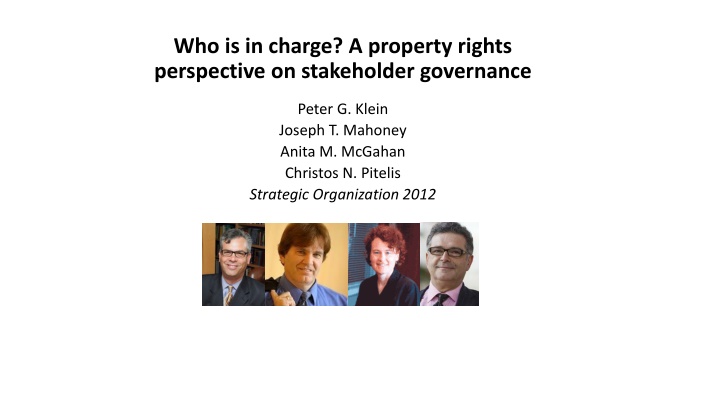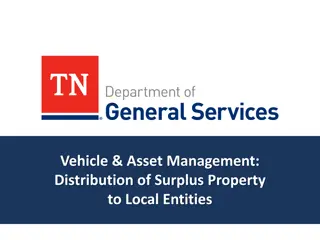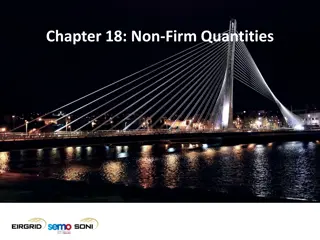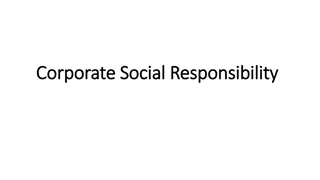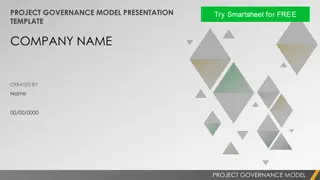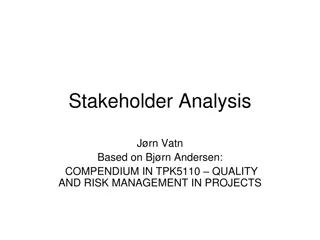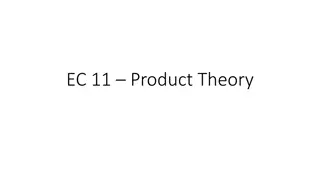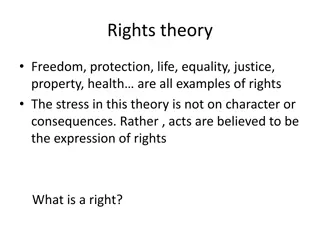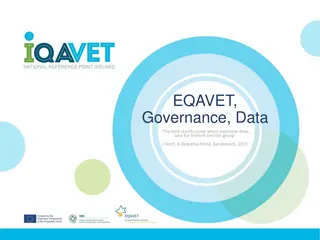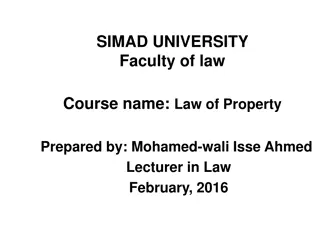Rethinking Firm Governance Through Property Rights and Stakeholder Theory
Challenging the traditional shareholder-centric view, this study explores how property rights theory and stakeholder theory can offer a more comprehensive perspective on firm governance. It delves into the complexities of value creation, contractual relationships, and diverse stakeholder interests, advocating for a synthesis of shareholder and stakeholder perspectives to enhance decision-making and value capture within organizations.
Download Presentation

Please find below an Image/Link to download the presentation.
The content on the website is provided AS IS for your information and personal use only. It may not be sold, licensed, or shared on other websites without obtaining consent from the author.If you encounter any issues during the download, it is possible that the publisher has removed the file from their server.
You are allowed to download the files provided on this website for personal or commercial use, subject to the condition that they are used lawfully. All files are the property of their respective owners.
The content on the website is provided AS IS for your information and personal use only. It may not be sold, licensed, or shared on other websites without obtaining consent from the author.
E N D
Presentation Transcript
Who is in charge? A property rights perspective on stakeholder governance Peter G. Klein Joseph T. Mahoney Anita M. McGahan Christos N. Pitelis Strategic Organization 2012
RESEARCH QUESTION / PROBLEM FORMULATION The paper calls into question the orthodox view that the purpose of the firm is to maximize returns on investment for equity shareholders. Problems associated with this dominant yet reductionist approach: misunderstandings regarding the firm s contractual obligations problematic and inaccurate representations of organization, innovation, and other aspects of value creation and capture neglecting the creation and capture of value via spillovers, relationship-specific investments, and complex contractual ties AUTHORS RESPONSE: Synthesis of the shareholder view with stakeholder theory reexplained considering property rights theory
SHAREHOLDER THEORY: OVERVIEW Based on agency theory Alchian and Demsetz (1972) and Jensen and Meckling (1976): The firm as a nexus of contracts Explicit contracts + ex-ante complete contracting Allows for asymmetric information and divergent goals between principals and agents Formal principal-agent models (e.g., Holmstrom, 1982): shareholders are the sole residual claimants No residual rights of control because contracts are complete (all future economic payoff- relevant contingencies are specified) Maximizing shareholder NPV = maximizing the NPV of the firm. CHALLENGES: TCE Modern property rights theory with incomplete contracting (Grossman & Hart, 1986) Stakeholder theory (Freeman, 1984; Clarkson, 1995)
STAKEHOLDER THEORY AS AN ALTERNATIVE PERSPECTIVE Stakeholders (aside from equity holders) = employees, suppliers, customers, and other economic agents that may also have legitimate claims to the economic value created by the firm Co-investments by buyers and suppliers make the firm s assets more valuable, so are integral to the firm s capacity for creating and capturing value Value defined by buyer willingness to pay and supplier opportunity cost The firm s residual income = (the firm s specific investments + investments of its transactional partners) division of created value among claimants Property rights theory: relevant stakeholders = all investors who create transaction/ firm-specific property (or otherwise deploy their own property) under the reasonable expectation of a return on investment through interaction with the firm Residual interest of stakeholders is created a priori
PROPERTY RIGHTS AND OWNERSHIP Consider different meanings of property rights Property rights = any sanctioned behavioral relations among decisionmakers in the use of potentially valuable resources; such sanctioned behaviors allow people the right to use resources within prescribed limits = legal + social Resources can be thought of as bundles of rights rather than physical entities In TCE, bundles of property rights allocations are ways to govern the division of economic rents to attenuate inefficient investment and appropriation
PROPERTY RIGHTS AND OWNERSHIP Classical property rights theory: Ownership = residual rights to income ex-ante, attenuates ex-post contractual issues Modern property rights theory: Ownership = residual control rights in the deployment of property ex-post, relevant only when contracts are incomplete Property rights theory essential for understanding economic value jointly created by a complex web of contractual partners (When contracting is incomplete and implicit, the effects of decisions on jointly owned assets and jointly created value especially difficult to discern) Both residual income and residual control are at the heart of ownership.
THE FIRM AS A NEXUS OF EXPLICIT AND IMPLICIT CONTRACTS The fundamental concept of ownership is under-theorized in shareholder- stakeholder debates Consideration of buyers and suppliers who have made transaction- and firm- specific investments based on their reasonable expectations The distinction between residual income and residual control rights Stakeholder theories must address not only how rights are distributed between firm owners and non-owners, but who is an owner and who isn t. Effects of implicit and incomplete contracting Infeasibility of identifying precisely the entire economic value created by the firm. Implicit contracts involve obligations that are mutually understood, and enforced via reputation, without being explicitly stated. The unfettered pursuit of shareholder wealth may lead the breach of valuable implicit contracts
TWO PROPERTY RIGHTS MODELS BLAIR AND STOUT (1999) MODEL GHM MODEL Emphasizes asset specificity and technical inseparabilities in team production Rajan and Zingales (1998): use the property rights mechanism of restricted access to critical assets, instead of ownership, to promote firm-specific investment Blair and Stout (1999): a team production approach to the public corporation Critical role of the board of directors as neutral decision-makers who maintain the balance of inducements and contributions Recognizes importance of co-specialized investment Narrow group of controlling stakeholders Residual control rights should be assigned to the parties whose relationship-specific investments have the largest marginal impact on joint value creation
CONCLUSIONS Why do business schools continue to teach, without qualification or reflection, the idea that maximizing shareholder wealth is equivalent to maximizing the economic value of the corporation? Ideology Desire to avoid seeming undisciplined, outside a Inertia Need for precise measurement
CONCLUSIONS We can do better a more complete understanding of the entire value chain requires looking beyond shareholder primacy The alignment of shareholder interests with those of trading partners is central to the value of the firm and shareholder wealth Such that one role of board of directors is to encourage the nexus of firm specific investments via mutual lock-in (i.e., a mutual commitment across stakeholders to a governance process) to safeguard such investments by stakeholders, which enables the firm to appropriate as much co-created value as possible Modern property rights perspective (incomplete and implicit contracting) + Value capture and co-creation Stakeholder value theory of the firm
